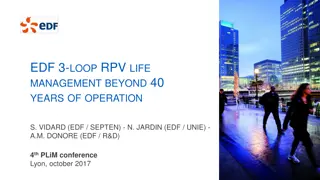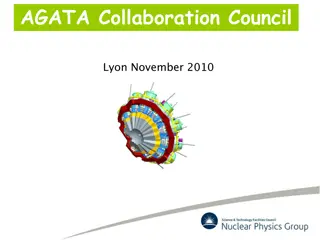Decentralized Biowaste Management for Sustainable Resource Valorization
The Decisive Final Conference presented a project focusing on decentralized biowaste management to collect and valorize biowaste from major producers. The project aimed to address challenges in biowaste processing and resource recovery. Key aspects included the difference between planned and actual outcomes, permitting processes, experimental periods, and waste collection strategies. The project demonstrated successful handling of biowaste from various suppliers, showcasing progress towards sustainable waste management practices.
Download Presentation

Please find below an Image/Link to download the presentation.
The content on the website is provided AS IS for your information and personal use only. It may not be sold, licensed, or shared on other websites without obtaining consent from the author.If you encounter any issues during the download, it is possible that the publisher has removed the file from their server.
You are allowed to download the files provided on this website for personal or commercial use, subject to the condition that they are used lawfully. All files are the property of their respective owners.
The content on the website is provided AS IS for your information and personal use only. It may not be sold, licensed, or shared on other websites without obtaining consent from the author.
E N D
Presentation Transcript
DECISIVE FINAL CONFERENCE: The way towards decentralized biowaste management Collecting and valorising biowaste from major producers Axelle Degueurce, INRAE This project has received funding from the European Union s Horizon 2020 research and innovation program under grant agreement No 689229.
The idea VS the reality OK Sources Restaurants, canteens, groceries stores Liquid: spreading plan 10kms away from the demonstration Permitting Plan: 50t/y Reality: 40 t/y Digestate spreading Collection Energy production Operation of digester Plan: > 1 year Reality: 3 months in a stable way Solid State Fermentation Plan: > 1 year Reality: 2 weeks Another site tested
The way through permitting Validation August 2019 (1 year process) Validation in 2019 Validation July 2020 ICPE (Rugulation for environmental No issues local authorities involved and supportive 1/ Declaration Only vegetables ABP category 3 Sanitary protection) Urbanism Final analysis after starting-up OK 2/ Registration Addition of meat Public consultation issues about noises, odors and property values 3/ Authorization Not necessary Spreading plan
Experimental periods 2019 2020 2021 March, 17th to May, 11th Oct 30th to Dec, 15th July, 31th October, 8th May, 5th Lock-down Lock-down Starting phase Stabilized operation COVID-19 Pandemic Regular feeding Installation of container All commercial restaurants closed Sampling Change in collection plan : addition of groceries stores and collective restaurants Inoculation Monitoring Ramp-up started Learning about the operation of the unit: Optimization of hygienisation heat Operation of the Stirling Feeding strategies + ABP DECISIVE- Lyon case 4
Collection 12 suppliers: 3 commercial restaurants 1 vegetable farm 4 groceries stores 4 collective canteens Social organization performing reverse logistic (vegetables delivery Food waste collection) Target 145 kg/d 63% of processed waste from collective or commercial restaurants Performed 114 kg/d 79% of the initial amount target really processed DECISIVE- Lyon case 5
Biogaz production Few days in June Target 1 m3/h Unstable monitoring Issues with Stirling engine Issues with feeding module 2 reliable periods: 0.6 0.2 m3/h in June 0.5 0.1 m3/h in July Feeding rate 132 kg/d Need to increase process performances Increase temperature Increase the hydraulic retention time Few days in July Target 1 m3/h Influence of the variability of biowaste Feeding rate 154 kg/d
Methane content Critical point to avoid failures of Stirling engine 40% of methane in biogas Limit of Stirling operation Optimal feeding rate 10 feedings/day: 15kg/2h30 Methane content: 47 2% DECISIVE- Lyon case 7
Characteristics of the digestate Digestate = Raw content of digester 55% of the maximal methane potential remaining in the digestate Ammonia content of the digestate higher than in pig manure Higher fertilizing potential DECISIVE- Lyon case 8
Characteristics of the digestate Digestate = Raw content of digester Metallic trace elements below the French regulation limit (NFU 44-051) DECISIVE- Lyon case 9
Solid state fermentation and post-treatment of digestate SSF Successfully performed with an industrial digestate in Barcelona Phase Separation Need 12-15% of total solid for SSF Not achieved Technology not suitable for the digestate of Lyon Vibrating screen Need another phase separation device (centrifugation or screw press) DECISIVE- Lyon case 10
Energetic balance (kWh/d) Thermal energy Electrical energy TOTAL Production 98 96 2 With Stirling Consumption 0 59 Heat the digester 65 Other devices (hygienization, stirring, shredding) 0 6 Thermal energy enough to cover heat demand of the digester and more Need to increase electrical energy Decrease the demand use the extra heat to perform hygienization Increase biogas production Need additional tests during wintertime
Take-home messages Other interests Performances Operation Regret Positive energetic balance in summer time Robust process Social (restaurants) Need additional experiments Need more time Enhancement possible 1 person full time Learning tool DECISIVE title 12












